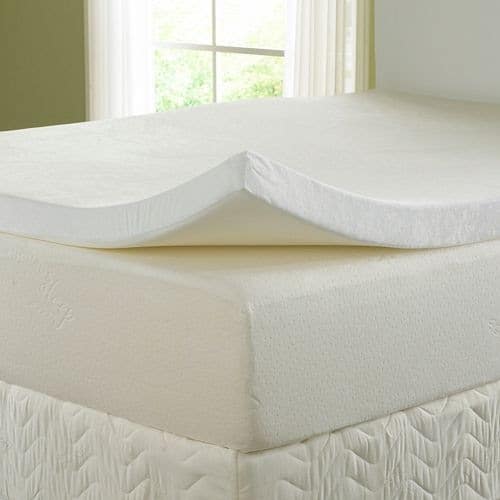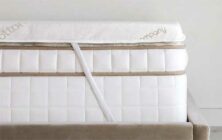Memory foam mattresses are solid, dense mattresses that combine a layer of memory foam with springs or support foam and provide remarkable support and comfort. Memory foam mattresses use body heat to soften and mold to the sleeper’s shape. The foam will slowly bounce back once the pressure is removed, but it will remember the sleeper’s body shape and optimal sleeping position over time. Check out our memory foam shopping guide to see what we think of a variety of mattresses on the market. If you already have a memory foam mattress or any other type of mattress, you may decide that you want to raise it for a variety of reasons. But how do you raise a memory foam mattress or any other mattress?
To raise a memory foam mattress, follow these steps: Measure how much you want to raise the mattress, pick a suitable box spring or mattress topper to raise the height, place the box spring on the bed frame or mattress, and place the mattress on top of the box spring. You can also use other mattress foundations such as bunkie boards or platforms to raise the height of your memory foam mattress.
Easy solution : add a topper (check our 3 favorite ones)
There are a few reasons why people tend to raise their mattresses. Raising the height of a bed can make it easier to get into, as many older adults or people with mobility issues may have trouble getting in and out of a low bed (for more information about issues people face when getting up from low surfaces, see this study). Raising your mattress can also make your bed look higher, which can make your bedroom look even more cozy and comfortable.
To raise a memory foam mattress or any other mattress, follow the steps we’ve listed below.
Step 1. Measure How Much You Want To Raise the Memory Foam Mattress
Use a measuring tape to determine the exact height of your mattress and decide what your ideal mattress height is. Keep in mind that bedding such as a mattress pad, sheets, or a comforter can also add to the height of the mattress. You may also find more useful information in our article, should you fold a mattress in half to move it as well.
To accommodate the bedding, add an additional 2 to 3 inches to the height of your mattress. Then, subtract the actual height of the mattress and any bedding from the measurement of your desired mattress height. This will tell you exactly how thick your box spring or other mattress support should be to give you the right bed height. Make sure that your mattress is fully expanded when you take this measurement. Sometimes, a memory foam mattress or mattress topper may not fully expand and you’ll need to help it along with our tips.
Step 2. Pick a Suitable Box Spring to Add Under Your Mattress
Using your measurement from step 1, select a box spring that’s the right thickness to raise your mattress to your preferred height. Box springs are cloth-covered wooden frames that traditionally contain springs; since they are quite thick, they are a popular way to provide extra height and mattress support. However, you can also choose to use an alternative type of mattress foundation like a bunkie board to raise your mattress, which we will discuss later in this article.
When selecting a box spring, keep an eye on the differences between low profile box springs (which are typically 5 to 6 inches tall) and high profile box springs (which are approximately 9 inches tall). You should also make sure to select a box spring that will match both the length and width of your mattress.
Examples of box springs you can use include:
- This highly rated Zinus Armita Box Spring which adds 5 inches
- This 9 inch Box Spring, also from Zinus
- This Keenan Box Spring which adds 14 inches
Step 3. Place the Box Spring on the Bed Frame
For this next step, remove your mattress from the bed frame. Carefully tilt the mattress on its side and prop it against a wall or another solid object that can support its weight.
Lift the box spring onto its side and slide it toward the bed. Then, lower the box spring slowly onto the bed frame and adjust the box spring to fit into the frame.
Step 4. Place the Mattress on top of the Box Spring
Finally, lift the mattress and place it on top of the box spring. Check the position of the mattress and make any adjustments so that it lines up with the box spring. Since memory foam mattresses and other mattresses can be quite heavy, you may want to have someone help you with this step to avoid injury.
Put any mattress toppers, sheets, or comforters back on the bed, and enjoy your newly raised mattress.
Step 5. Alternatively, Add A Memory Foam Mattress Topper to Raise Your Mattress Height
A simple memory foam mattress topper can also be placed on top of your mattress to add a few inches, increase comfort, and increase the thickness of your memory foam without purchasing a new mattress altogether.
For example, this highly rated gel memory foam mattress topper adds 4 inches. Make sure to check out our in-depth guide on choosing a mattress topper for more detailed information. You may also be interested in learning how to choose the right mattress topper to help hip pain too.
Should You Stack Mattress Foundations To Raise the Height of a Mattress?
You shouldn’t stack mattress foundations to raise the height of a mattress because it can be an additional cost and might make the mattress too high. Mattress foundations come in many different heights, so you should be able to find one that meets your needs without stacking them. However, if you really want to stack mattress foundations, consider stacking multiple bunkie boards or plywood platforms rather than box springs.
Stacking box springs is generally not recommended because they’re relatively expensive. Also, since traditional box springs are so tall, stacking two could make your bed quite high and possibly difficult to get into. However, if you have an extra box spring lying around, or if you’re comfortable with the additional height and cost, you may want to stack them.
Bunkie boards are thin, flat mattress foundations that are commonly used as an alternative to box springs. If you really want to stack mattress foundations to raise a mattress, consider stacking bunkie boards or plywood platforms; because they’re thinner, they will be easier to stack and less likely to make the bed too high. Here’s an example of a 1.5 inch thick bunkie board that can be stacked. Since bunkie boards and plywood are less expensive than box springs, it won’t cost too much to stack these types of mattress foundations. Make sure to take a look at our more detailed article about mattress foundations vs bed frames to find additional information.
How To Raise a Gel Foam Mattress
Gel foam mattresses are mattresses that combine gel foam with a spring or foam base. Gel foam is a type of foam mixed with gel beads that provides extra support and helps to reduce heat build-up. But how do you raise a gel foam mattress?
To raise a gel foam mattress, follow the steps listed above for raising a memory foam mattress: measure how much you want to raise the mattress, pick a suitable box spring, place the box spring on the bed frame, and place the mattress on top of the box spring.
The main difference between memory foam mattresses and gel foam mattresses is that gel foam disperses heat better than memory foam. However, since gel foam mattresses can be used with box springs just like any other type of mattress, you can follow the exact same process to raise a gel foam mattress as you would with a memory foam mattress.
How To Choose an Alternative Mattress Foundation That Can Raise the Height of a Memory Foam Mattress
Once you’ve chosen your ideal mattress, it’s important to find the right mattress foundation. A mattress foundation is the support system you use to hold up your mattress, protect it, and make it last longer. Box springs are the most popular type of mattress foundation, but there are other types like platforms and bunkie boards that you can use to support your mattress and raise its height.
To choose a mattress foundation that can raise the height of a mattress, consider how much you want to raise your mattress and how much you’re willing to spend on a mattress foundation. Bunkie boards are quite thin and inexpensive, so they are a good option if you’re on a budget or want to raise your mattress slightly. Box springs and platforms, on the other hand, are much taller, but they’re also more expensive.
A mattress foundation like this one can add as much as 16 inches to the height of your bed, making it easier to get in and out of bed and keeping you away from cold air, humidity, dust, and other allergens that dwell on the floor. For more information about dust and other bedroom allergens, see this study. Below, we’ll discuss the heights of different mattress foundations and how they can raise a mattress.
Bunkie Boards Are Great Alternatives to Box Springs, to raise the height of a Mattress
As we mentioned earlier in the article, bunkie boards are thin, flat mattress supports. They are usually made of plywood or particleboard and are a simple and cost-effective way to provide a solid base for memory foam mattresses or any other type of mattress.
Bunkie boards provide the same support as a box spring without the added height, making them a great choice if you don’t want to raise your mattress very much. You can also top a box spring or platform with a bunkie board for additional support and height. This bunkie board adds 1.6 inches.
If you’re on a budget, you can make your own bunkie board using a piece of plywood. With a plywood bunkie board, you can choose the thickness of the plywood based on how much you want to raise your mattress. If you choose to customize your own plywood bunkie board, you should treat or cover the plywood immediately. Plywood is prone to chipping, so it can easily snag your mattress or sheets if left untreated. These plywood slats add 1.5 inches and cost only ~$60.
Box Springs come in Low and High Profile Versions (As Alternatives to Standard Box Springs)
As we mentioned previously, box springs are cloth-covered wooden frames that traditionally have a layer of steel coils inside. Traditional box springs are quite tall, so they are a good choice if you want to raise a mattress significantly.
If you want to use a box spring to raise your mattress but you don’t want it to be too high, consider getting a low profile box spring. Low profile box springs are a few inches shorter than traditional box springs, and their slim design can keep the mattress at a more comfortable height while still raising it more than a bunkie board or plywood foundation.
Platforms Can Include Frames or Entire Platform Beds with Solid or Slatted Bases – These can increase the height of your mattress more or less compared to your existing bed frame
Platforms are usually rectangular wooden frames with a flat base. Platform beds are often lower to the floor than traditional bed frames, and they usually come with a slatted or solid support surface. We recommend using a slatted platform for better ventilation, as a solid foundation risks trapping body heat (for more information about bed ventilation and how temperature can affect sleep, see this study). However, make sure that the slats aren’t more than 3 inches apart to prevent the mattress from sagging between the slats.
If you’d like to raise your platform, you can always add a bunkie board on top of the slats. If you want to raise your mattress by a specific height and are having trouble finding the right way to raise it, you may even want to consider crafting your own platform out of plywood so that you can customize the height of your mattress.
Other articles you may enjoy:




